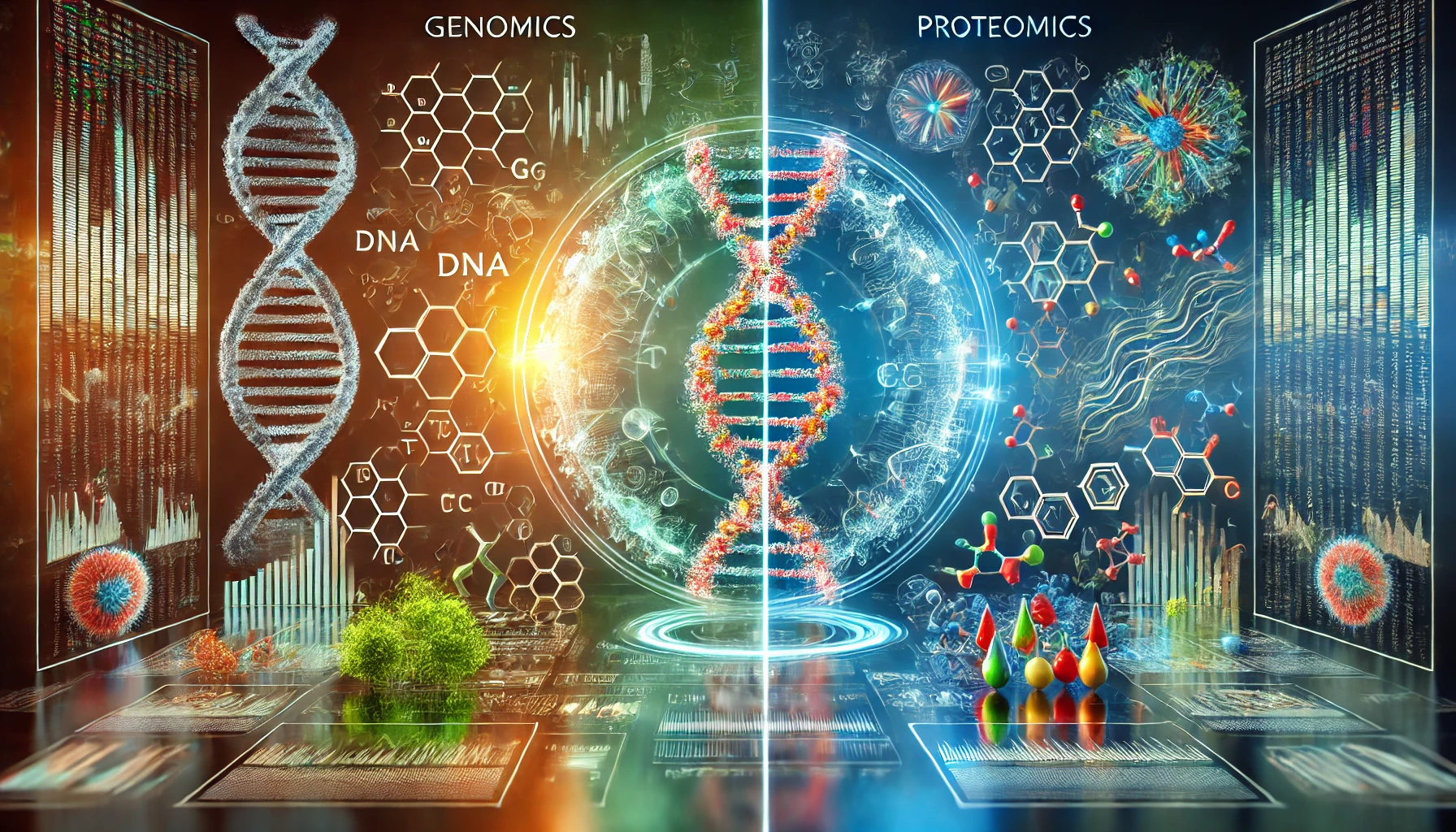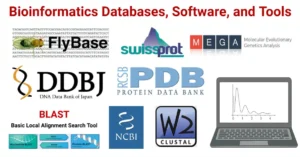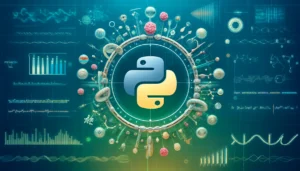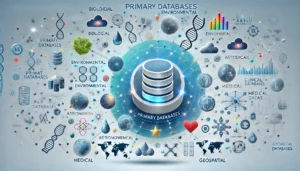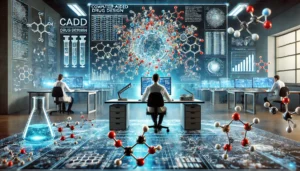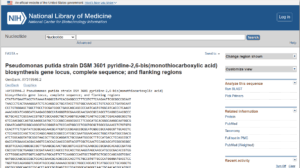Genomics and proteomics are two critical fields in molecular biology that focus on understanding the structure, function, and interactions of genetic material and proteins within living organisms. Both areas of study have revolutionized the way we approach health, disease, and the potential for therapeutic interventions. Below is a detailed exploration of these fields, their importance, and how they are interconnected.
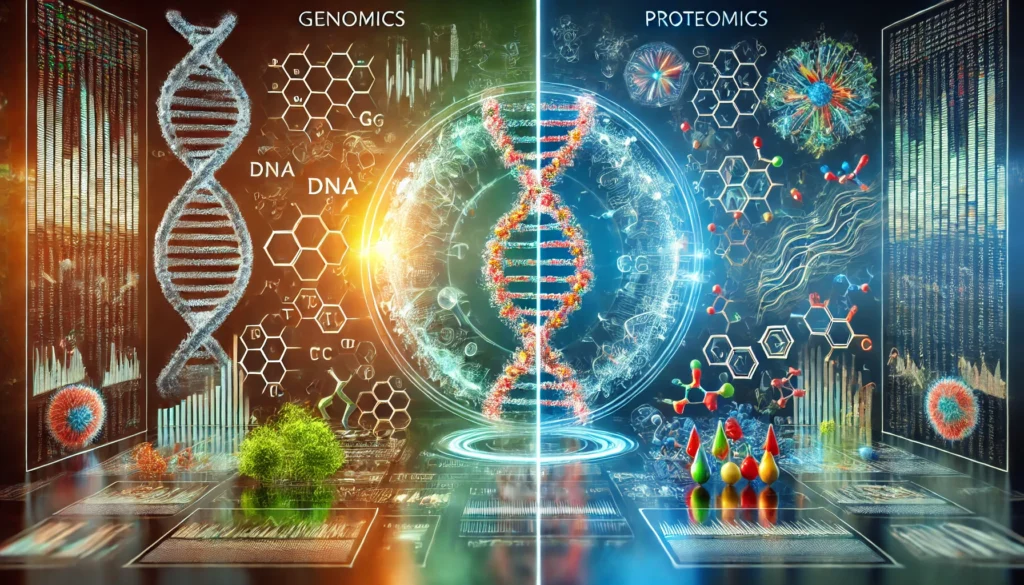
Genomics: An Introduction
Genomics is the study of an organism’s complete set of genes and their interactions within the genome. The human genome, for instance, consists of approximately 3 billion DNA base pairs, encoding roughly 20,000–25,000 genes. Genomics focuses on understanding the structure, function, evolution, and mapping of genomes. The ultimate goal is to better understand how genes influence biological functions and contribute to health and disease.
Key Concepts in Genomics:
- DNA Sequencing:
- The process of determining the exact sequence of nucleotides in a DNA molecule.
- Technologies like Sanger sequencing and next-generation sequencing (NGS) have drastically increased sequencing throughput and accuracy.
- NGS allows for high-throughput sequencing, making whole-genome sequencing more accessible.
- Gene Mapping:
- Identifying the location of genes on chromosomes.
- Involves techniques like linkage analysis and comparative genomics to correlate genetic markers with diseases.
- Functional Genomics:
- The study of gene function and expression, typically using techniques like RNA-Seq to assess how genes are transcribed into RNA.
- Investigates gene regulation, mutations, and gene interactions within cellular contexts.
- Comparative Genomics:
- The analysis of genomes from different species to understand evolutionary relationships.
- Allows for the identification of conserved genes and regulatory regions, offering insights into essential biological processes.
Key Applications of Genomics:
- Personalized Medicine:
- Genomic information can be used to tailor medical treatments to individual patients based on their genetic makeup.
- Pharmacogenomics studies how genetic variations influence responses to drugs.
- Disease Diagnosis and Risk Assessment:
- Genomic data can identify predispositions to genetic diseases like cancer, cardiovascular diseases, and rare inherited conditions.
- Techniques like genome-wide association studies (GWAS) help identify genetic variants associated with specific diseases.
- Gene Therapy:
- Genomics is central to developing gene therapies aimed at treating genetic disorders by inserting, altering, or repairing genes within a patient’s cells.
- Agricultural Genomics:
- The use of genomics in crop and livestock breeding to develop better yield, disease resistance, and climate adaptation.
- Examples include genetically modified organisms (GMOs) and CRISPR-based gene editing for enhanced agricultural productivity.
Proteomics: An Introduction
Proteomics is the large-scale study of proteins, particularly their functions, structures, and interactions. Proteins are the molecular machines of cells, performing a wide range of tasks, from catalyzing biochemical reactions to providing structural support. Proteomics aims to understand how proteins contribute to cellular processes and how their dysfunction leads to disease.
Key Concepts in Proteomics:
- Protein Identification:
- Involves techniques such as mass spectrometry (MS), two-dimensional gel electrophoresis (2D-GE), and Western blotting to identify proteins in biological samples.
- MS is particularly important for identifying and characterizing proteins, providing insights into their structure and post-translational modifications.
- Protein Quantification:
- Determining the abundance of proteins within a given sample.
- Methods like label-free quantification, stable isotope labeling, and tandem mass tagging (TMT) are used to compare protein expression levels in different conditions.
- Post-Translational Modifications (PTMs):
- Proteins often undergo modifications after translation, such as phosphorylation, acetylation, and glycosylation, which influence their activity, stability, and function.
- Proteomics plays a key role in studying PTMs and understanding their impact on cellular signaling and disease.
- Protein Interactions (Interactomics):
- Investigates how proteins interact with each other to form complexes that drive cellular processes.
- Techniques like co-immunoprecipitation (Co-IP), yeast two-hybrid screening, and affinity purification-mass spectrometry (AP-MS) help identify protein-protein interactions.
- Structural Proteomics:
- The study of protein structures to understand their functions.
- Approaches like X-ray crystallography, NMR spectroscopy, and cryo-electron microscopy (cryo-EM) allow scientists to examine protein 3D structures in detail.
Key Applications of Proteomics:
- Biomarker Discovery:
- Proteomics plays a crucial role in identifying proteins that can serve as biomarkers for diseases such as cancer, Alzheimer’s disease, and diabetes.
- Biomarkers are used for early detection, monitoring disease progression, and evaluating the effectiveness of treatments.
- Drug Development:
- Understanding protein structures and functions can lead to the development of small molecules or biologics that target specific proteins involved in diseases.
- Proteomics helps in identifying drug targets and evaluating drug efficacy.
- Systems Biology:
- Proteomics is a core component of systems biology, where the focus is on understanding the entire biological system rather than individual components.
- By studying proteins and their interactions, scientists can build comprehensive models of cellular pathways and networks.
- Functional Annotation of the Genome:
- Proteomics complements genomics by linking genes to their protein products and functions, allowing for better understanding of gene function in the context of the whole organism.
Genomics and Proteomics: The Interplay
Genomics and proteomics are inherently linked, as the genomic blueprint determines the proteins that are produced in a cell. Together, they provide a holistic view of biology at the molecular level. Here’s how they complement each other:
- Gene Expression: Genomics provides information about the transcription of genes into RNA, while proteomics focuses on the translation of this RNA into proteins. Understanding gene expression patterns alongside protein expression helps scientists interpret how genetic variations lead to disease.
- Gene-to-Protein Relationships: The genome contains the instructions for creating proteins, but many proteins require modification or complex interactions to function properly. Proteomics helps elucidate these processes, bridging the gap between the static DNA code and the dynamic activity of proteins.
- Functional Genomics and Proteomics: Combining data from both fields enables a deeper understanding of biological processes. For example, a change in gene expression may lead to altered protein levels, which can then be studied for their functional consequences on cellular pathways.
Future Directions in Genomics and Proteomics
- Integration of Multi-Omic Data: The future of genomics and proteomics lies in integrating data from various “omics” fields, including transcriptomics (RNA), metabolomics (metabolites), and epigenomics (DNA modifications), to create comprehensive models of cellular function and disease mechanisms.
- Single-Cell Genomics and Proteomics: Advances in single-cell technology are enabling scientists to study the genomic and proteomic profiles of individual cells, providing a more detailed understanding of cellular heterogeneity and disease progression.
- Artificial Intelligence and Machine Learning: AI and machine learning algorithms are being used to analyze complex genomic and proteomic datasets. These technologies have the potential to accelerate discoveries in drug development, personalized medicine, and biomarker identification.
- CRISPR and Gene Editing: The development of gene-editing technologies like CRISPR-Cas9 is poised to revolutionize both genomics and proteomics by allowing targeted manipulation of genes and proteins, leading to potential therapeutic applications.
Key Differences: Genomics vs. Proteomics
| S.N. | Character | Genomics | Proteomics |
|---|---|---|---|
| 1. | Definition | Genomics is the study of genomes, which refers to the complete set of genes or genetic material present in a cell or organism. | Proteomics is the branch of molecular biology that studies the set of proteins expressed by the genome of an organism. |
| 2. | Study of | Genomics is the study of the genes in an organism. | Proteomics is the study of all the proteins in a cell. |
| 3. | Unit under Study | The study of the function of genomes. | The study of the function of proteomes. |
| 4. | Nature of Study Material | The genome is constant. Every cell of an organism has the same set of genes. | The proteome is dynamic and varies. The set of proteins produced in different tissues varies according to gene expression. |
| 5. | Use of High Throughput Techniques | High throughput techniques are used in genomics to map, sequence, and analyze genomes. | In proteomics, characterization of the 3D structure and the function of proteins is carried out by high throughput methods. |
| 6. | Techniques Involved | Techniques include gene sequencing strategies like directed gene sequencing, whole-genome shotgun sequencing, construction of expressed sequence tags (ESTs), identification of single nucleotide polymorphisms (SNPs), and data analysis with software and databases. | Techniques include protein extraction, electrophoretic separation, digestion of proteins with trypsin, mass spectrometry for amino acid sequence, and identification using protein databases. 3D structure prediction and protein microarrays are also used. |
| 7. | Types | Two types: Structural genomics and functional genomics. | Three types: Structural, functional, and expression proteomics. |
| 8. | Important Areas | Genome sequencing projects such as the Human Genome Project are key areas. | Proteome database developments like SWISS-2DPAGE and software for computer-aided drug design are important areas. |
| 9. | Importance | Genomic studies are important for understanding the structure, function, location, and regulation of genes in an organism. | Proteomics helps understand the structure and function of the entire set of proteins produced by a cell. |
| 10. | Significance | Genes in the nucleus may not accurately portray conditions in the cell due to regulation at the RNA and protein level, which cannot be viewed in genomics studies. | Proteomics studies are more beneficial because proteins are the functional molecules in cells, directly representing actual conditions. |
Conclusion
Genomics and proteomics are central to understanding the molecular foundation of life. While genomics decodes the genetic instructions, proteomics interprets these instructions in the form of proteins that carry out essential cellular functions. Together, these disciplines are advancing our ability to diagnose, treat, and prevent diseases, shaping the future of medicine, agriculture, and biotechnology.
